Gustav Nebehay
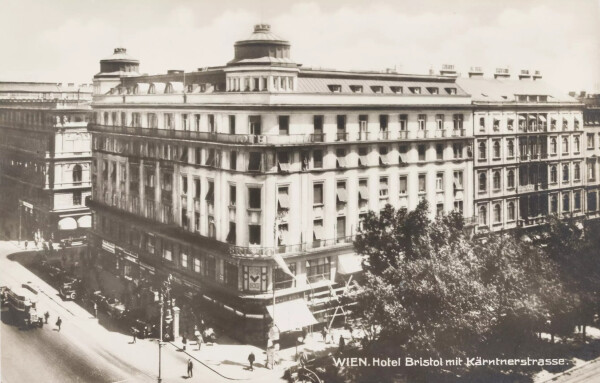
Hotel Bristol after 1913, the Nebehay art dealership was on the 1st floor
© Wien Museum
As a promoter of young Austrian art and successful art dealer, Gustav Nebehay was friends with Gustav Klimt and Egon Schiele. He exhibited their works, including Klimt’s estate, at his art dealership at Hotel Bristol.
Gustav Nebehay was born on 26 June 1881 in Vienna. The son of an innkeeper, he was the youngest of 16 children.
At the age of 14, he began an apprenticeship at the renowned Viennese bookshop run by Rudolf Heger. In 1900, Nebehay moved to Leipzig, where he started to work at Rossberg’s bookshop. There, he met the dealer of books and art, Hans Boerner, whose bookstore C. G. Boerner specialized in old prints. Gustav Nebehay soon became a partner of his firm, where he gained first experience as an art dealer and organized numerous important auctions of graphic works by Old Masters. The company C. G. Boerner invariably focused on old prints and never on works by contemporary artists. His dedication to his work enabled Nebehay to establish himself as an internationally renowned dealer of art and prints.
On 3 June 1908, he married Maria Sonntag, a sister of the eminent Leipzig art book binder Carl Sonntag jun.. The couple had five children. The oldest son Christian M. Nebehay became an author who wrote various comprehensive documentary works on Gustav Klimt.
During World War I, Gustav Nebehay was called up for military service and moved to Vienna. Seeing as he suffered from the separation from his family, he brought them to Vienna in 1917 and built his own company there towards the end of the War. The art dealership Gustav Nebehay was situated in a top location, at Hotel Bristol, in the 1st District of Vienna. The premises, which could be entered via a separate entrance on the Ringstraße, were made up of a courtyard with a glass roof, a second exhibition room and an office. His emphasis was on art from the Viennese School of the 19th and early 20th centuries.
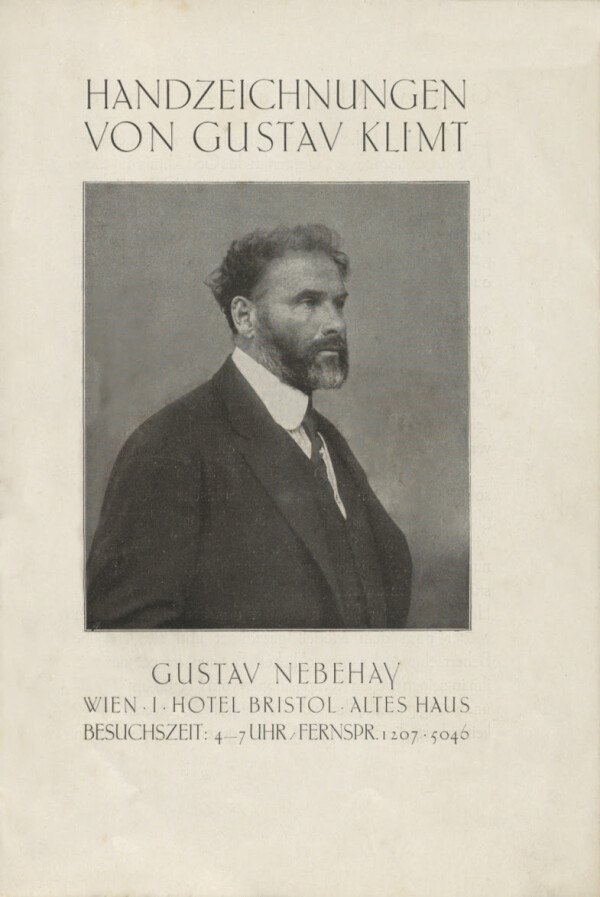
Gustav Nebehay Kunsthandlung (Hg.): Handzeichnungen von Gustav Klimt, Ausst.-Kat., Gustav Nebehay art dealership (Vienna), 00.09.1918–00.10.1918, Vienna 1918.
© Vienna City Library
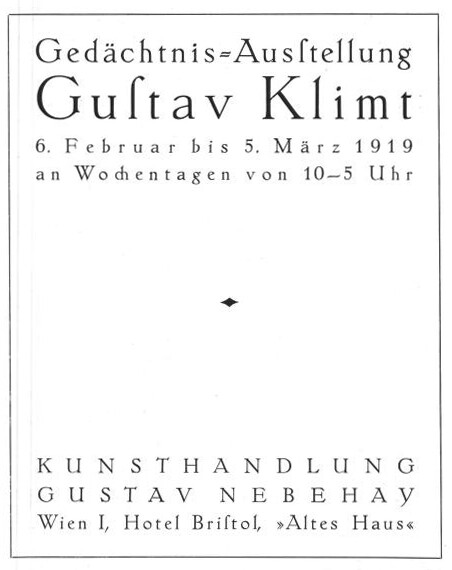
Die bildenden Künste. Wiener Monatshefte, 2. Jg. (1919).
© ANNO | Austrian National Library
Artist Friends and Skittles Evenings
Owing to his profession, Nebehay became a member of Vienna’s artistic circles. Among his first contacts was Josef Hoffmann, who in 1916 designed a bracelet as a present for Nebehay’s wife Maria, and in 1924/25 redecorated the premises of the art dealer’s shop at Hotel Bristol together with the Wiener Werkstätte. On account of this friendship, Nebehay was often invited to skittles evenings at Restaurant Hartmann, whose regular participants included numerous Viennese artists. Along with Hoffmann, Nebehay’s circle of friends and acquaintances soon included the painter and educator Franz Čižek, who gave his son Christian art lessons, Egon Schiele, Otto Lendecke as well as Gustav Klimt.
Nebehay became especially close with Klimt. The painter visited the Nebehay family in the spring of 1917 at their rooms at the “Pechhütte,” a snack-bar in Unter St. Veit, a visit that is mentioned in an entry in Klimt’s last notebook. The relationship between the famous painter and the art dealer’s family is further documented by several drawings. During the above-mentioned visit, Klimt gifted the Nebehays various works on paper. On request from the art dealer, he added the dedications “Dedicated to Mrs. Maria Nebehay” and “Dedicated to Mr. Gustav Nebehay in friendship” as well as his characteristic oval signature.
That the art dealer attended Klimt’s funeral less than a year later is documented by a photograph taken on the occasion, showing him with Emilie Flöge, Josef Hoffmann, Berta Zuckerkandl and Julius Tandler. Shortly before, he had planned to organize a sizeable exhibition of Klimt’s paintings and drawings at his art salon at Hotel Bristol, though this never came to pass owing to Klimt’s sudden death in February 1918. Instead, Nebehay put on a type of memorial exhibition of drawings which he had purchased from Klimt in the summer of 1917. In the spring of 1918, he and Klimt’s long-standing friend Carl Moll further organized the presentation “Ein Jahrhundert Wiener Malerei in Zürich” [“A Century of Viennese Painting in Zurich”], with an entire room dedicated to Klimt as a tribute to the artist.
Gustav Nebehay as a Dealer of Klimt’s Art
Klimt’s heirs decided to sell the artist’s estate via Gustav Nebehay. To this end, the art dealership Gustav Nebehay held the extensive “Gedächtnis=Ausstellung Gustav Klimt” [“Exhibition in Commemoration of Gustav Klimt”] in 1919, which featured some 20 paintings, numerous drawings, as well as the majority of the master’s collection of Asian art and studio furniture.
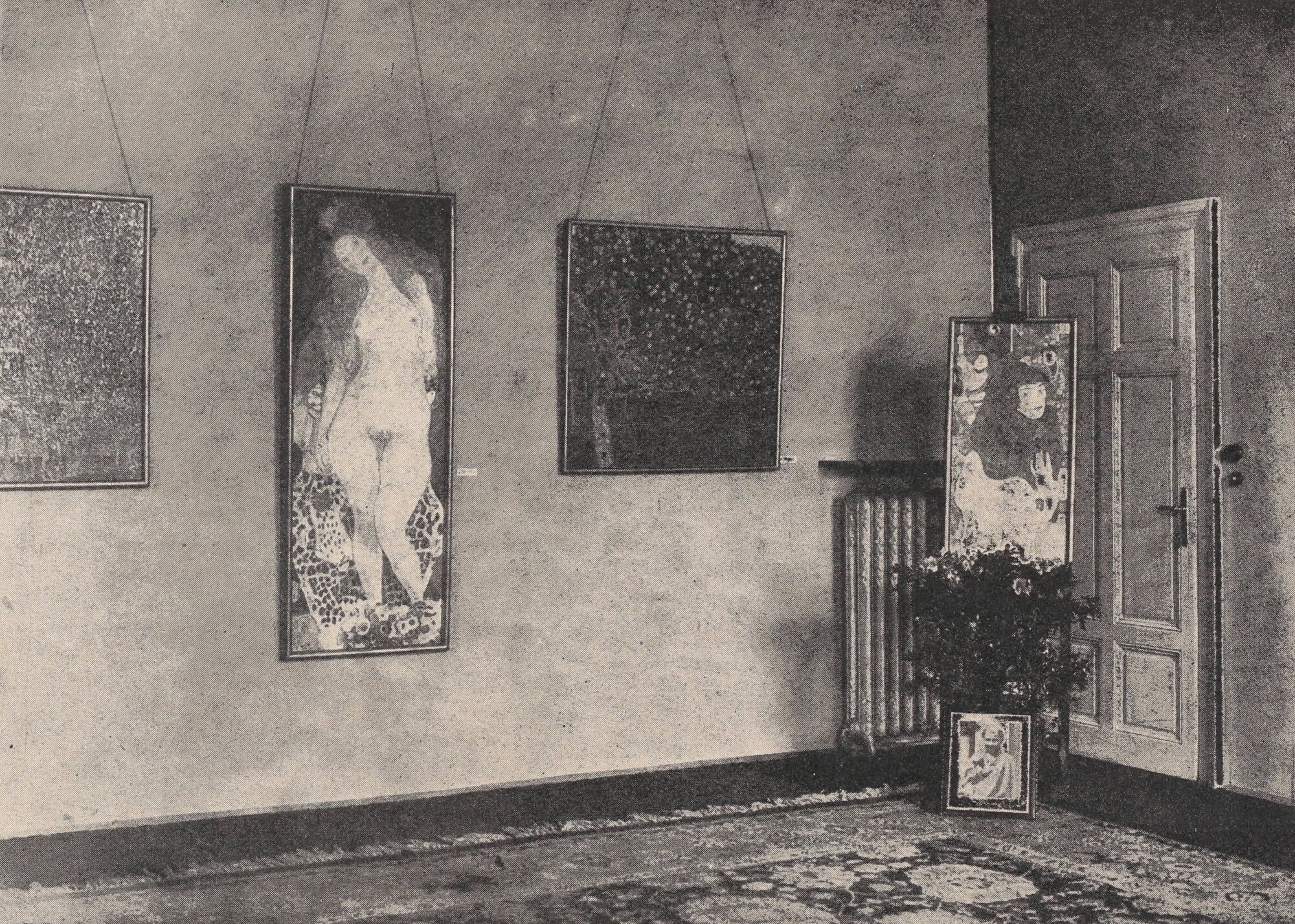
Insight into the Gustav Klimt memorial exhibition, February 1919 - March 1919
© Klimt Foundation, Vienna
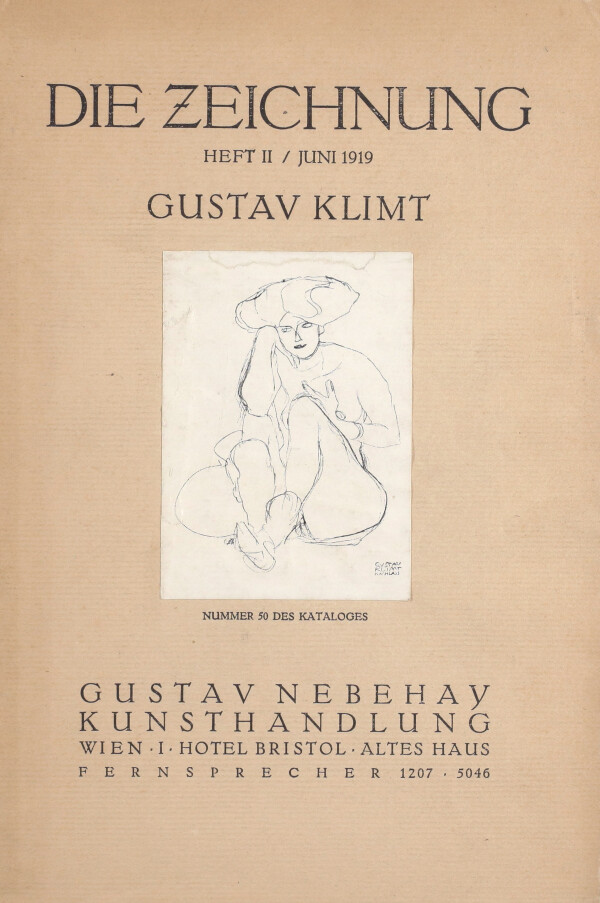
Gustav Nebehay Kunsthandlung (Hg.): Die Zeichnungen. Heft II Juni 1919. Gustav Klimt, Ausst.-Kat., Gustav Nebehay art dealership (Vienna), 00.06.1919–00.00.1919, Vienna 1919.
© Klimt Foundation, Vienna
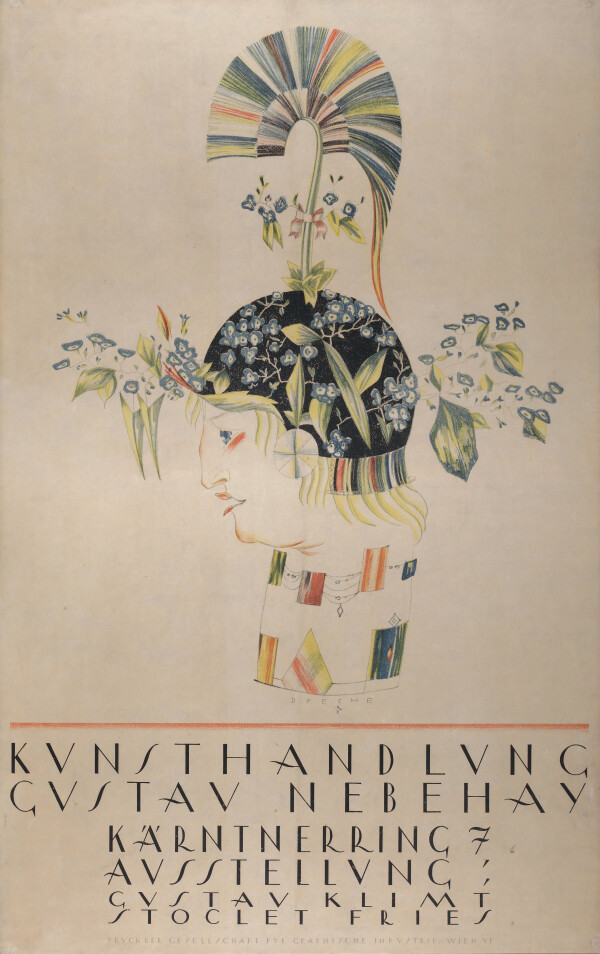
Dagobert Peche: Poster for the Gustav Klimt-Stoclet Fries exhibition at the Gustav Nebehay art dealership, 1920
© Klimt Foundation, Vienna
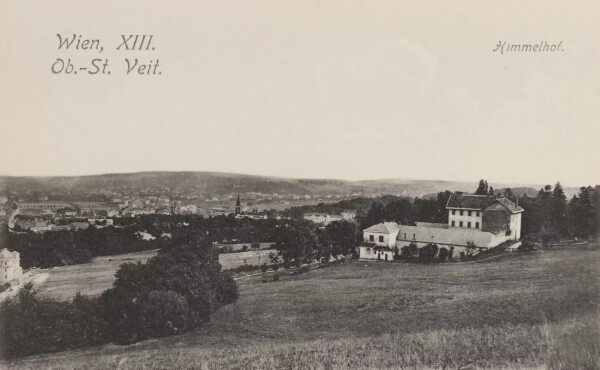
Himmelhof, home of the Nebehay family from the 1920s onwards
© Wien Museum
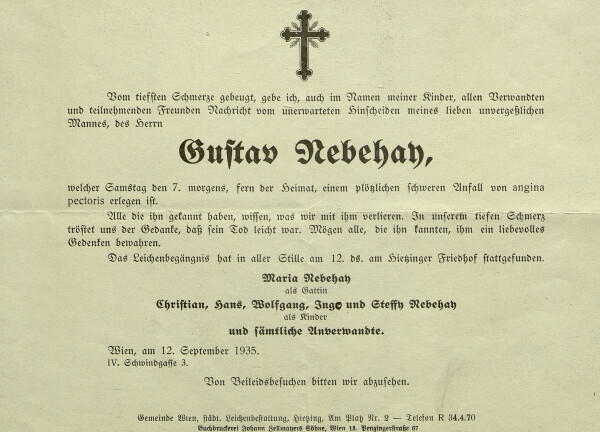
© Vienna City Library
The sales of these works yielded sums that would have been unheard of during Klimt’s lifetime. A letter from Emilie Flöge to Klimt’s brother Georg reveals that Nebehay offered to continue selling drawings on the heirs’ behalf after the end of the exhibition:
“Dear Georg! Mr. Nebehay informs me that the exhibition has closed and that, prior to returning the unsold works, he wants to make me the following offer: He would keep back approx. 300 drawings of various quality, and would keep selling them on behalf of Klimt’s heirs. His terms are 25% of the proceeds of the drawings.”
Thus, a second exhibition was held that year, which exclusively featured Klimt drawings. Among the buyers and customers of the art dealer’s were important art collectors, including Sonja Knips, Mäda Primavesi and Serena Lederer, who purchased the majority of their Klimt drawings from Mr. Nebehay’s estate exhibition. Likely due to the increased workload, Nebehay briefly employed Friederike Beer-Monti in 1918 as an assistant, who in 1916 had been portrayed by Klimt. Among her tasks was to mark the drawings with an estate stamp to make them clearly identifiable.
Nebehay took action to prevent the work of this artist of the century from falling into oblivion after his death. In 1920, he made Klimt’s preparatory drawings for The Stoclet Frieze (1905–1911, private collection) accessible to the public for the first time. The exhibition was advertised with a poster designed by Dagobert Peche especially for this occasion. Soon after the presentation, the drafts were acquired by the Museum of Applied Arts, where they are kept to this day.
Gustav Nebehay had become the official expert for the sale of Klimt’s works. Thus, it is not surprising that Joseph Urban approached Nebehay in 1922 when he was looking for Klimt paintings for his Wiener Werkstaette of America. He purchased a total of three works through Gustav Nebehay’s art dealership. Owing to his renown as a successful art dealer, Nebehay was also asked to sell the estates of his friends Egon Schiele and Otto Lendecke. Among the art dealer’s employees was Maria Hauffen, Nebehay’s secretary, as well as Eduard Kosmack, who, until 1914, had been a publisher and, as a member of Klimt’s skittles party, had worked closely with artists of the Wiener Werkstätte in the past.
In the 1920s, Nebehay bought a property known as “Himmelhof” in Unter St. Veit, where he now lived with his family. The house soon became a meeting place for famous artists, including Remigius Geyling, Eugen Hamm, Dagobert Peche, Georg Kolbe and Ludwig Heinrich Jungnickel. Nebehay was known to give impoverished artist friends and their families asylum for weeks at a time. Nebehay’s circle of friends also included directors of important museum, such as Alfred Stix, the managing director of Austrian museums and the Albertina, and Franz Martin Haberditzl, the director of the Belvedere, who made numerous acquisitions for their institutions via his art dealership. The generous businessman sometimes also gifted works to the museums, when their budgets did not allow for acquisitions.
End of the Art Dealership and Retreat from Vienna
Towards the late 1920s, the financial situation of the art dealership deteriorated. Moreover, Nebehay was diagnosed with diabetes. Likely for these reasons, he hastily closed down his art dealer’s shop in Vienna in 1928 to move to Berlin without his family, as his wife had refused to accompany him. There, he opened up a new shop at Schöneberger Ufer 37.
Several months after moving to Berlin, he was commissioned to sell the world-famous collection of the late Viennese art collector Albert Figdor. However, the prestigious commission would become his undoing. The sale attracted a lot of attention in the media, and was examined in several newspaper articles in Vienna and Berlin. By the time the collection was finally sold at auctions in Vienna and Berlin more than two years later in 1930, Nebehay had undergone numerous tough legal battles and sustained significant financial losses from neglecting his other business. His art dealership in Berlin was liquidated, and Nebehay never re-established his reputation in his line of work.
Nebehay died on 7 September 1935 during a stay at a health spa in Marienbad (now: Mariánské Lázně, Czech Republic) at the age of 54 from heart failure.
Literature and sources
- Wien Geschichte Wiki. Gustav Nebehay. www.geschichtewiki.wien.gv.at/Gustav_Nebehay (04/16/2020).
- N. N.: Theater, Kunst und Literatur. Kunst, in: Wiener Allgemeine Zeitung (Morgenausgabe), 17.09.1918, S. 3.
- Österreichisches Biographisches Lexikon. Gustav Nebehay. www.biographien.ac.at/oebl/oebl_N/Nebehay_Gustav_1881_1935.xml (04/16/2020).
- ILAB. International LEAGUE of ANTIQUARIAN BOOKSELLERS. ilab.org/articles/50-years-wiener-antiquariat-50-jahre-wiener-antiquariat (04/16/2020).
- Gustav Nebehay Kunsthandlung (Hg.): Die Zeichnung, Heft 2, Vienna 1919.
- Sandra Tretter, Peter Weinhäupl, Felizitas Schreier, Georg Becker (Hg.): Gustav Klimt. Atelier Feldmühlgasse 1911–1918, Vienna 2014.
- Der Cicerone. Halbmonatsschrift für die Interessen des Kunstforschers & Sammlers, 11. Jg., Heft 7 (1919), S. 202.
- Christian Nebehay: Die goldenen Sessel meines Vaters, Vienna 1983.
- Alice Strobl (Hg.): Gustav Klimt. Die Zeichnungen, Band III, 1912–1918, Salzburg 1984, S. 30, Nr. 2219.
- Brief von Emilie Flöge in Wien an Georg Klimt (10.03.1919). S104.
- Gustav Nebehay Kunsthandlung (Hg.): Handzeichnungen von Gustav Klimt, Ausst.-Kat., Gustav Nebehay art dealership (Vienna), 00.09.1918–00.10.1918, Vienna 1918.
- Brief von Mary Urban in New York an Philipp Häusler in Wien (20.03.1922). HIN 2.1.3.10.5.20, .
- Allgemeine Sport-Zeitung, 23.06.1923, S. 299.
- Brief von Anne Moore in New York an Philip Häusler in Wien (undatiert). HIN 2.1.3.10.5.9, .
- Berliner Tageblatt und Handels-Zeitung (Morgenausgabe), 28.06.1928, S. 11.
- Notizbuch von Gustav Klimt (vermutlich 1917).
- Christian M. Nebehay: Gustav Klimt. Von der Zeichnung zum Bild, Vienna 1992, S. 228-231.

